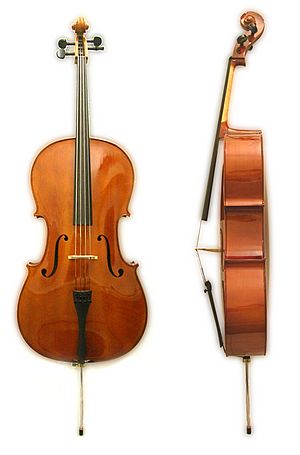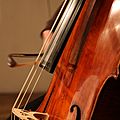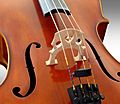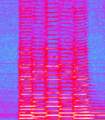Cello facts for kids
The cello is a large string instrument that makes beautiful music. Its name comes from Italian, and you say it "chello." The full name is violoncello, but most people just call it a cello. Someone who plays the cello is called a "cellist." It is a very popular instrument and belongs to the string family.
Cellos are used in many ways. You can hear them as a solo instrument, in small groups called chamber music, and in large orchestras. Sometimes, pop musicians like The Beatles, Björk, and Jamiroquai also use the cello in their songs.
Contents
How the Cello Came to Be
The cello first appeared in the 16th century. Back then, there were many different string instruments. One family of instruments was called the viols. The violin family was also developing. People were trying out instruments of all shapes and sizes.
A popular bass instrument was the violone, which was like a modern double bass. The name violoncello means "little violone." The cello also has four strings. It became the main bass instrument in string groups. Later, the double bass was added to play the same notes an octave lower.
At first, the cello mostly played along with other instruments, like the left hand of a harpsichord player. This was called basso continuo. But soon, composers started writing special parts for the cello. They gave it small solos in pieces called concerti grossi. This is how the cello began to be a solo instrument.
Johann Sebastian Bach wrote six very famous pieces for solo cello. These are called suites. They are some of the most beautiful music ever written for the cello.
Cello Music Through the Years
After Bach, other composers started writing solo music for the cello. Joseph Haydn wrote two solo concertos for it. King Frederick William II of Prussia loved the cello. He encouraged composers like Haydn, Mozart, and Beethoven to write interesting cello parts. The cello was no longer just a simple bass instrument. It was now as important as the other string instruments.
In the 19th century, many famous composers wrote cello music. Some of them, like Carl Davidov, David Popper, and Julius Klengel, were cellists themselves. Other famous composers who wrote important cello music include Mendelssohn, Chopin, Schumann, Brahms, Dvořák, Fauré, Saint-Saëns, Elgar, and Sergei Rakhmaninov.
More recently, two famous pieces for cello and orchestra are the Cello Symphony by Benjamin Britten and The Protecting Veil by John Tavener.
Playing the Cello
The cello has parts similar to a violin. Its four strings are tuned to C-G-D-A, from the lowest note to the highest. When you play the cello, you sit down. You hold the instrument between your knees. There is a metal rod called an end-pin that rests on the floor. You can adjust its height to make yourself comfortable. The cello is usually played with a bow.
The cello makes a deep, rich sound. Its lowest note is two octaves below middle C. But it can also play very high notes. For the highest notes, cellists can use a special technique called "thumb position." This means the left thumb presses down on the strings high up on the fingerboard. This is closer to the bridge, where the high notes are.
Cello music is often written using the bass clef. However, because the cello can play quite high, the tenor clef is also used, especially in solo music.
Famous Cellists
One of the most famous cellists from the early 1900s was Pablo Casals from Spain. He helped make the cello popular as a solo instrument today. Casals also found the famous Suites for cello by J.S. Bach, which had been lost for many years.
Other famous cellists from the last century include Emanuel Feuermann, Gregor Piatigorski, Paul Tortelier, Jacqueline du Pré, and Mstislav Rostropovich.
Today, some well-known cellists are Yo-Yo Ma, Julian Lloyd Webber, Mischa Maisky, Tim Hugh, Robert Cohen, Pieter Wispelwey, and Truls Mørk.
- The New Grove Dictionary of Music & Musicians ed. Stanley Sadie; 1980, ISBN: 1-56159-174-2
Images for kids
-
The Servais Stradivarius is preserved in the Smithsonian Institution's National Museum of American History
See also
 In Spanish: Violonchelo para niños
In Spanish: Violonchelo para niños


















